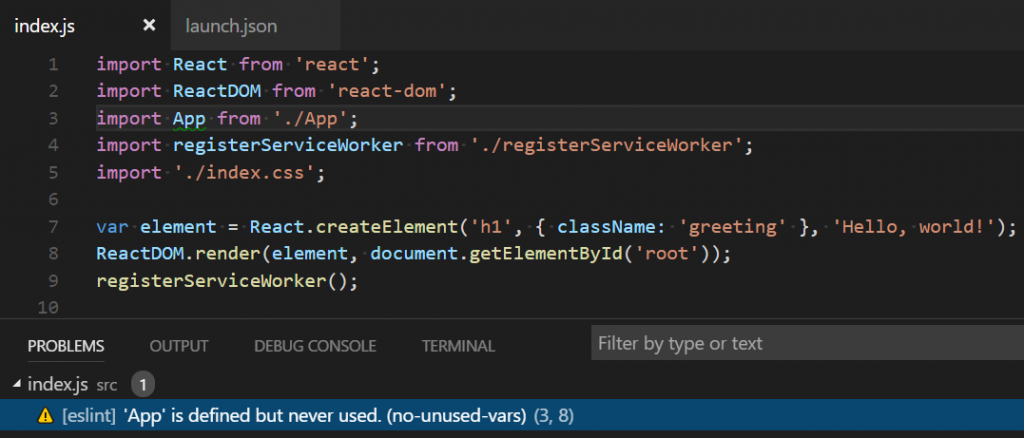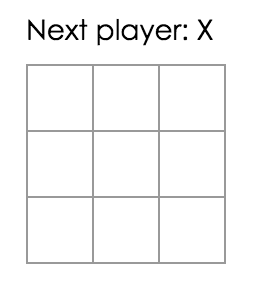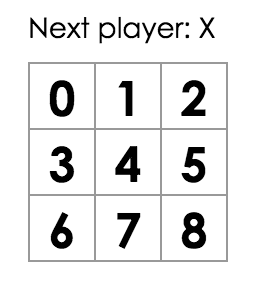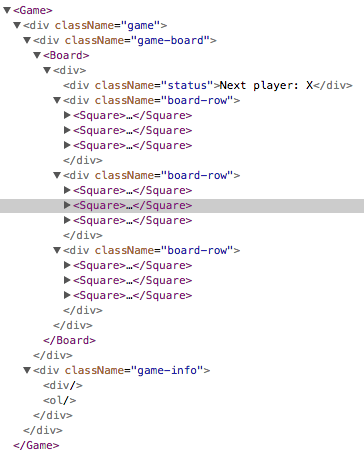Tutorial: Intro To React
Before We Start
What We’re Building
Today, we’re going to build an interactive tic-tac-toe game.
If you like, you can check out the final result here: Final Result. Don’t worry if the code doesn’t make sense to you yet, or if it uses an unfamiliar syntax. We will be learning how to build this game step by step throughout this tutorial.
Try playing the game. You can also click on a button in the move list to go “back in time” and see what the board looked like just after that move was made.
Once you get a little familiar with the game, feel free to close that tab, as we’ll start from a simpler template in the next sections.
Prerequisites
We’ll assume some familiarity with HTML and JavaScript, but you should be able to follow along even if you haven’t used them before.
If you need a refresher on JavaScript, we recommend reading this guide. Note that we’re also using some features from ES6, a recent version of JavaScript. In this tutorial, we’re using arrow functions, classes, let, and const statements. You can use Babel REPL to check what ES6 code compiles to.
How to Follow Along
There are two ways to complete this tutorial: you could either write the code right in the browser, or you could set up a local development environment on your machine. You can choose either option depending on what you feel comfortable with.
If You Prefer to Write Code in the Browser
This is the quickest way to get started!
First, open this starter code in a new tab. It should display an empty tic-tac-toe field. We will be editing that code during this tutorial.
You can now skip the next section about setting up a local development environment and head straight to the overview.
If You Prefer to Write Code in Your Editor
Alternatively, you can set up a project on your computer.
Note: this is completely optional and not required for this tutorial!
This is more work, but lets you work from the comfort of your editor.
If you want to do it, here are the steps to follow:
- Make sure you have a recent version of Node.js installed.
- Follow the installation instructions to create a new project.
npm install -g create-react-app
create-react-app my-app
- Delete all files in the
src/folder of the new project (don’t delete the folder, just its contents).
cd my-app
rm -f src/*
- Add a file named
index.cssin thesrc/folder with this CSS code. - Add a file named
index.jsin thesrc/folder with this JS code. - Add these three lines to the top of
index.jsin thesrc/folder:import React from 'react'; import ReactDOM from 'react-dom'; import './index.css';
Now if you run npm start in the project folder and open http://localhost:3000 in the browser, you should see an empty tic-tac-toe field.
We recommend following these instructions to configure syntax highlighting for your editor.
Help, I’m Stuck!
If you get stuck, check out the community support resources. In particular, Reactiflux chat is a great way to get quick help. If you don’t get a good answer anywhere, please file an issue, and we’ll help you out.
With this out of the way, let’s get started!
Overview
What is React?
React is a declarative, efficient, and flexible JavaScript library for building user interfaces.
React has a few different kinds of components, but we’ll start with React.Componentsubclasses:
class ShoppingList extends React.Component {
render() {
return (
<div className="shopping-list">
<h1>Shopping List for {this.props.name}</h1>
<ul>
<li>Instagram</li>
<li>WhatsApp</li>
<li>Oculus</li>
</ul>
</div>
);
}
}
// Example usage: <ShoppingList name="Mark" />
We’ll get to the funny XML-like tags in a second. Your components tell React what you want to render – then React will efficiently update and render just the right components when your data changes.
Here, ShoppingList is a React component class, or React component type. A component takes in parameters, called props, and returns a hierarchy of views to display via the rendermethod.
The render method returns a description of what you want to render, and then React takes that description and renders it to the screen. In particular, render returns a React element, which is a lightweight description of what to render. Most React developers use a special syntax called JSX which makes it easier to write these structures. The <div /> syntax is transformed at build time to React.createElement('div'). The example above is equivalent to:
return React.createElement('div', {className: 'shopping-list'},
React.createElement('h1', /* ... h1 children ... */),
React.createElement('ul', /* ... ul children ... */)
);
If you’re curious, createElement() is described in more detail in the API reference, but we won’t be using it directly in this tutorial. Instead, we will keep using JSX.
You can put any JavaScript expression within braces inside JSX. Each React element is a real JavaScript object that you can store in a variable or pass around your program.
The ShoppingList component only renders built-in DOM components, but you can compose custom React components just as easily, by writing <ShoppingList />. Each component is encapsulated so it can operate independently, which allows you to build complex UIs out of simple components.
Getting Started
Start with this example: Starter Code.
It contains the shell of what we’re building today. We’ve provided the styles so you only need to worry about the JavaScript.
In particular, we have three components:
- Square
- Board
- Game
The Square component renders a single <button>, the Board renders 9 squares, and the Game component renders a board with some placeholders that we’ll fill in later. None of the components are interactive at this point.
Passing Data Through Props
Just to get our feet wet, let’s try passing some data from the Board component to the Square component.
In Board’s renderSquare method, change the code to pass a value prop to the Square:
class Board extends React.Component {
renderSquare(i) {
return <Square value={i} />;
}
Then change Square’s render method to show that value by replacing {/* TODO */} with {this.props.value}:
class Square extends React.Component {
render() {
return (
<button className="square">
{this.props.value}
</button>
);
}
}
Before:
After: You should see a number in each square in the rendered output.
An Interactive Component
Let’s make the Square component fill in an “X” when you click it. Try changing the button tag returned in the render() function of the Square like this:
class Square extends React.Component {
render() {
return (
<button className="square" onClick={() => alert('click')}>
{this.props.value}
</button>
);
}
}
If you click on a square now, you should get an alert in your browser.
This uses the new JavaScript arrow function syntax. Note that we’re passing a function as the onClick prop. Doing onClick={alert('click')} would alert immediately instead of when the button is clicked.
React components can have state by setting this.state in the constructor, which should be considered private to the component. Let’s store the current value of the square in state, and change it when the square is clicked.
First, add a constructor to the class to initialize the state:
class Square extends React.Component {
constructor(props) {
super(props);
this.state = {
value: null,
};
}
render() {
return (
<button className="square" onClick={() => alert('click')}>
{this.props.value}
</button>
);
}
}
In JavaScript classes, you need to explicitly call super(); when defining the constructor of a subclass.
Now change the Square render method to display the value from the current state, and to toggle it on click:
- Replace
this.props.valuewiththis.state.valueinside the<button>tag. - Replace the
() => alert()event handler with() => this.setState({value: 'X'}).
Now the <button> tag looks like this:
class Square extends React.Component {
constructor(props) {
super(props);
this.state = {
value: null,
};
}
render() {
return (
<button className="square" onClick={() => this.setState({value: 'X'})}>
{this.state.value}
</button>
);
}
}
Whenever this.setState is called, an update to the component is scheduled, causing React to merge in the passed state update and rerender the component along with its descendants. When the component rerenders, this.state.value will be 'X' so you’ll see an X in the grid.
If you click on any square, an X should show up in it.
Developer Tools
The React Devtools extension for Chrome and Firefox lets you inspect a React component tree in your browser devtools.
It lets you inspect the props and state of any of the components in your tree.
After installing it, you can right-click any element on the page, click “Inspect” to open the developer tools, and the React tab will appear as the last tab to the right.
However, note there are a few extra steps to get it working with CodePen:
- Log in or register and confirm your email (required to prevent spam).
- Click the “Fork” button.
- Click “Change View” and then choose “Debug mode”.
- In the new tab that opens, the devtools should now have a React tab.
Lifting State Up
We now have the basic building blocks for a tic-tac-toe game. But right now, the state is encapsulated in each Square component. To make a fully-working game, we now need to check if one player has won the game, and alternate placing X and O in the squares. To check if someone has won, we’ll need to have the value of all 9 squares in one place, rather than split up across the Square components.
You might think that Board should just inquire what the current state of each Square is. Although it is technically possible to do this in React, it is discouraged because it tends to make code difficult to understand, more brittle, and harder to refactor.
Instead, the best solution here is to store this state in the Board component instead of in each Square – and the Board component can tell each Square what to display, like how we made each square display its index earlier.
When you want to aggregate data from multiple children or to have two child components communicate with each other, move the state upwards so that it lives in the parent component. The parent can then pass the state back down to the children via props, so that the child components are always in sync with each other and with the parent.
Pulling state upwards like this is common when refactoring React components, so let’s take this opportunity to try it out. Add a constructor to the Board and set its initial state to contain an array with 9 nulls, corresponding to the 9 squares:
class Board extends React.Component {
constructor(props) {
super(props);
this.state = {
squares: Array(9).fill(null),
};
}
renderSquare(i) {
return <Square value={i} />;
}
render() {
const status = 'Next player: X';
return (
<div>
<div className="status">{status}</div>
<div className="board-row">
{this.renderSquare(0)}
{this.renderSquare(1)}
{this.renderSquare(2)}
</div>
<div className="board-row">
{this.renderSquare(3)}
{this.renderSquare(4)}
{this.renderSquare(5)}
</div>
<div className="board-row">
{this.renderSquare(6)}
{this.renderSquare(7)}
{this.renderSquare(8)}
</div>
</div>
);
}
}
We’ll fill it in later so that a board looks something like
[
'O', null, 'X',
'X', 'X', 'O',
'O', null, null,
]
Board’s renderSquare method currently looks like this:
renderSquare(i) {
return <Square value={i} />;
}
Modify it to pass a value prop to Square.
renderSquare(i) {
return <Square value={this.state.squares[i]} />;
}
Now we need to change what happens when a square is clicked. The Board component now stores which squares are filled, which means we need some way for Square to update the state of Board. Since component state is considered private, we can’t update Board’s state directly from Square.
The usual pattern here is pass down a function from Board to Square that gets called when the square is clicked. Change renderSquare in Board again so that it reads:
renderSquare(i) {
return (
<Square
value={this.state.squares[i]}
onClick={() => this.handleClick(i)}
/>
);
}
We split the returned element into multiple lines for readability, and added parens around it so that JavaScript doesn’t insert a semicolon after return and break our code.
Now we’re passing down two props from Board to Square: value and onClick. The latter is a function that Square can call. Let’s make the following changes to Square:
- Replace
this.state.valuewiththis.props.valuein Square’srender. - Replace
this.setState()withthis.props.onClick()in Square’srender. - Delete
constructordefinition from Square because it doesn’t have state anymore.
After these changes, the whole Square component looks like this:
class Square extends React.Component {
render() {
return (
<button className="square" onClick={() => this.props.onClick()}>
{this.props.value}
</button>
);
}
}
Now when the square is clicked, it calls the onClick function that was passed by Board. Let’s recap what happens here:
- The
onClickprop on the built-in DOM<button>component tells React to set up a click event listener. - When the button is clicked, React will call the
onClickevent handler defined in Square’srender()method. - This event handler calls
this.props.onClick(). Square’s props were specified by the Board. - Board passed
onClick={() => this.handleClick(i)}to Square, so, when called, it runsthis.handleClick(i)on the Board. - We have not defined the
handleClick()method on the Board yet, so the code crashes.
Note that DOM <button> element’s onClick attribute has a special meaning to React, but we could have named Square’s onClick prop or Board’s handleClick method differently. It is, however, conventional in React apps to use on* names for the attributes and handle* for the handler methods.
Try clicking a square – you should get an error because we haven’t defined handleClick yet. Add it to the Board class.
class Board extends React.Component {
constructor(props) {
super(props);
this.state = {
squares: Array(9).fill(null),
};
}
handleClick(i) {
const squares = this.state.squares.slice();
squares[i] = 'X';
this.setState({squares: squares});
}
renderSquare(i) {
return (
<Square
value={this.state.squares[i]}
onClick={() => this.handleClick(i)}
/>
);
}
render() {
const status = 'Next player: X';
return (
<div>
<div className="status">{status}</div>
<div className="board-row">
{this.renderSquare(0)}
{this.renderSquare(1)}
{this.renderSquare(2)}
</div>
<div className="board-row">
{this.renderSquare(3)}
{this.renderSquare(4)}
{this.renderSquare(5)}
</div>
<div className="board-row">
{this.renderSquare(6)}
{this.renderSquare(7)}
{this.renderSquare(8)}
</div>
</div>
);
}
}
We call .slice() to copy the squares array instead of mutating the existing array. Jump ahead a section to learn why immutability is important.
Now you should be able to click in squares to fill them again, but the state is stored in the Board component instead of in each Square, which lets us continue building the game. Note how whenever Board’s state changes, the Square components rerender automatically.
Square no longer keeps its own state; it receives its value from its parent Board and informs its parent when it’s clicked. We call components like this controlled components.
Why Immutability Is Important
In the previous code example, we suggest using the .slice() operator to copy the squaresarray prior to making changes and to prevent mutating the existing array. Let’s talk about what this means and why it is an important concept to learn.
There are generally two ways for changing data. The first method is to mutate the data by directly changing the values of a variable. The second method is to replace the data with a new copy of the object that also includes desired changes.
Data change with mutation
var player = {score: 1, name: 'Jeff'};
player.score = 2;
// Now player is {score: 2, name: 'Jeff'}
Data change without mutation
var player = {score: 1, name: 'Jeff'};
var newPlayer = Object.assign({}, player, {score: 2});
// Now player is unchanged, but newPlayer is {score: 2, name: 'Jeff'}
// Or if you are using object spread syntax proposal, you can write:
// var newPlayer = {...player, score: 2};
The end result is the same but by not mutating (or changing the underlying data) directly we now have an added benefit that can help us increase component and overall application performance.
Easier Undo/Redo and Time Travel
Immutability also makes some complex features much easier to implement. For example, further in this tutorial we will implement time travel between different stages of the game. Avoiding data mutations lets us keep a reference to older versions of the data, and switch between them if we need to.
Tracking Changes
Determining if a mutated object has changed is complex because changes are made directly to the object. This then requires comparing the current object to a previous copy, traversing the entire object tree, and comparing each variable and value. This process can become increasingly complex.
Determining how an immutable object has changed is considerably easier. If the object being referenced is different from before, then the object has changed. That’s it.
Determining When to Re-render in React
The biggest benefit of immutability in React comes when you build simple pure components. Since immutable data can more easily determine if changes have been made, it also helps to determine when a component requires being re-rendered.
To learn more about shouldComponentUpdate() and how you can build pure componentstake a look at Optimizing Performance.
Functional Components
We’ve removed the constructor, and in fact, React supports a simpler syntax called functional components for component types like Square that only consist of a render method. Rather than define a class extending React.Component, simply write a function that takes props and returns what should be rendered.
Replace the whole Square class with this function:
function Square(props) {
return (
<button className="square" onClick={props.onClick}>
{props.value}
</button>
);
}
You’ll need to change this.props to props both times it appears. Many components in your apps will be able to be written as functional components: these components tend to be easier to write and React will optimize them more in the future.
While we’re cleaning up the code, we also changed onClick={() => props.onClick()} to just onClick={props.onClick}, as passing the function down is enough for our example. Note that onClick={props.onClick()} would not work because it would call props.onClick immediately instead of passing it down.
Taking Turns
An obvious defect in our game is that only X can play. Let’s fix that.
Let’s default the first move to be by ‘X’. Modify our starting state in our Board constructor:
class Board extends React.Component {
constructor(props) {
super(props);
this.state = {
squares: Array(9).fill(null),
xIsNext: true,
};
}
Each time we move we shall toggle xIsNext by flipping the boolean value and saving the state. Now update Board’s handleClick function to flip the value of xIsNext:
handleClick(i) {
const squares = this.state.squares.slice();
squares[i] = this.state.xIsNext ? 'X' : 'O';
this.setState({
squares: squares,
xIsNext: !this.state.xIsNext,
});
}
Now X and O take turns. Next, change the “status” text in Board’s render so that it also displays who is next:
render() {
const status = 'Next player: ' + (this.state.xIsNext ? 'X' : 'O');
return (
// the rest has not changed
After these changes you should have this Board component:
class Board extends React.Component {
constructor(props) {
super(props);
this.state = {
squares: Array(9).fill(null),
xIsNext: true,
};
}
handleClick(i) {
const squares = this.state.squares.slice();
squares[i] = this.state.xIsNext ? 'X' : 'O';
this.setState({
squares: squares,
xIsNext: !this.state.xIsNext,
});
}
renderSquare(i) {
return (
<Square
value={this.state.squares[i]}
onClick={() => this.handleClick(i)}
/>
);
}
render() {
const status = 'Next player: ' + (this.state.xIsNext ? 'X' : 'O');
return (
<div>
<div className="status">{status}</div>
<div className="board-row">
{this.renderSquare(0)}
{this.renderSquare(1)}
{this.renderSquare(2)}
</div>
<div className="board-row">
{this.renderSquare(3)}
{this.renderSquare(4)}
{this.renderSquare(5)}
</div>
<div className="board-row">
{this.renderSquare(6)}
{this.renderSquare(7)}
{this.renderSquare(8)}
</div>
</div>
);
}
}
Declaring a Winner
Let’s show when a game is won. Add this helper function to the end of the file:
function calculateWinner(squares) {
const lines = [
[0, 1, 2],
[3, 4, 5],
[6, 7, 8],
[0, 3, 6],
[1, 4, 7],
[2, 5, 8],
[0, 4, 8],
[2, 4, 6],
];
for (let i = 0; i < lines.length; i++) {
const [a, b, c] = lines[i];
if (squares[a] && squares[a] === squares[b] && squares[a] === squares[c]) {
return squares[a];
}
}
return null;
}
You can call it in Board’s render function to check if anyone has won the game and make the status text show “Winner: [X/O]” when someone wins.
Replace the status declaration in Board’s render with this code:
render() {
const winner = calculateWinner(this.state.squares);
let status;
if (winner) {
status = 'Winner: ' + winner;
} else {
status = 'Next player: ' + (this.state.xIsNext ? 'X' : 'O');
}
return (
// the rest has not changed
You can now change handleClick in Board to return early and ignore the click if someone has already won the game or if a square is already filled:
handleClick(i) {
const squares = this.state.squares.slice();
if (calculateWinner(squares) || squares[i]) {
return;
}
squares[i] = this.state.xIsNext ? 'X' : 'O';
this.setState({
squares: squares,
xIsNext: !this.state.xIsNext,
});
}
Congratulations! You now have a working tic-tac-toe game. And now you know the basics of React. So you’re probably the real winner here.
Storing a History
Let’s make it possible to revisit old states of the board so we can see what it looked like after any of the previous moves. We’re already creating a new squares array each time a move is made, which means we can easily store the past board states simultaneously.
Let’s plan to store an object like this in state:
history = [
{
squares: [
null, null, null,
null, null, null,
null, null, null,
]
},
{
squares: [
null, null, null,
null, 'X', null,
null, null, null,
]
},
// ...
]
We’ll want the top-level Game component to be responsible for displaying the list of moves. So just as we pulled the state up before from Square into Board, let’s now pull it up again from Board into Game – so that we have all the information we need at the top level.
First, set up the initial state for Game by adding a constructor to it:
class Game extends React.Component {
constructor(props) {
super(props);
this.state = {
history: [{
squares: Array(9).fill(null),
}],
xIsNext: true,
};
}
render() {
return (
<div className="game">
<div className="game-board">
<Board />
</div>
<div className="game-info">
<div>{/* status */}</div>
<ol>{/* TODO */}</ol>
</div>
</div>
);
}
}
Then change Board so that it takes squares via props and has its own onClick prop specified by Game, like the transformation we made for Square earlier. You can pass the location of each square into the click handler so that we still know which square was clicked. Here is a list of steps you need to do:
- Delete the
constructorin Board. - Replace
this.state.squares[i]withthis.props.squares[i]in Board’srenderSquare. - Replace
this.handleClick(i)withthis.props.onClick(i)in Board’srenderSquare.
Now the whole Board component looks like this:
class Board extends React.Component {
handleClick(i) {
const squares = this.state.squares.slice();
if (calculateWinner(squares) || squares[i]) {
return;
}
squares[i] = this.state.xIsNext ? 'X' : 'O';
this.setState({
squares: squares,
xIsNext: !this.state.xIsNext,
});
}
renderSquare(i) {
return (
<Square
value={this.props.squares[i]}
onClick={() => this.props.onClick(i)}
/>
);
}
render() {
const winner = calculateWinner(this.state.squares);
let status;
if (winner) {
status = 'Winner: ' + winner;
} else {
status = 'Next player: ' + (this.state.xIsNext ? 'X' : 'O');
}
return (
<div>
<div className="status">{status}</div>
<div className="board-row">
{this.renderSquare(0)}
{this.renderSquare(1)}
{this.renderSquare(2)}
</div>
<div className="board-row">
{this.renderSquare(3)}
{this.renderSquare(4)}
{this.renderSquare(5)}
</div>
<div className="board-row">
{this.renderSquare(6)}
{this.renderSquare(7)}
{this.renderSquare(8)}
</div>
</div>
);
}
}
Game’s render should look at the most recent history entry and can take over calculating the game status:
render() {
const history = this.state.history;
const current = history[history.length - 1];
const winner = calculateWinner(current.squares);
let status;
if (winner) {
status = 'Winner: ' + winner;
} else {
status = 'Next player: ' + (this.state.xIsNext ? 'X' : 'O');
}
return (
<div className="game">
<div className="game-board">
<Board
squares={current.squares}
onClick={(i) => this.handleClick(i)}
/>
</div>
<div className="game-info">
<div>{status}</div>
<ol>{/* TODO */}</ol>
</div>
</div>
);
}
Since Game is now rendering the status, we can delete <div className="status">{status}</div> and the code calculating the status from the Board’s render function:
render() {
return (
<div>
<div className="board-row">
{this.renderSquare(0)}
{this.renderSquare(1)}
{this.renderSquare(2)}
</div>
<div className="board-row">
{this.renderSquare(3)}
{this.renderSquare(4)}
{this.renderSquare(5)}
</div>
<div className="board-row">
{this.renderSquare(6)}
{this.renderSquare(7)}
{this.renderSquare(8)}
</div>
</div>
);
}
Next, we need to move the handleClick method implementation from Board to Game. You can cut it from the Board class, and paste it into the Game class.
We also need to change it a little, since Game state is structured differently. Game’s handleClick can push a new entry onto the stack by concatenating the new history entry to make a new history array.
handleClick(i) {
const history = this.state.history;
const current = history[history.length - 1];
const squares = current.squares.slice();
if (calculateWinner(squares) || squares[i]) {
return;
}
squares[i] = this.state.xIsNext ? 'X' : 'O';
this.setState({
history: history.concat([{
squares: squares,
}]),
xIsNext: !this.state.xIsNext,
});
}
At this point, Board only needs renderSquare and render; the state initialization and click handler should both live in Game.
Showing the Moves
Let’s show the previous moves made in the game so far. We learned earlier that React elements are first-class JS objects and we can store them or pass them around. To render multiple items in React, we pass an array of React elements. The most common way to build that array is to map over your array of data. Let’s do that in the render method of Game:
render() {
const history = this.state.history;
const current = history[history.length - 1];
const winner = calculateWinner(current.squares);
const moves = history.map((step, move) => {
const desc = move ?
'Go to move #' + move :
'Go to game start';
return (
<li>
<button onClick={() => this.jumpTo(move)}>{desc}</button>
</li>
);
});
let status;
if (winner) {
status = 'Winner: ' + winner;
} else {
status = 'Next player: ' + (this.state.xIsNext ? 'X' : 'O');
}
return (
<div className="game">
<div className="game-board">
<Board
squares={current.squares}
onClick={(i) => this.handleClick(i)}
/>
</div>
<div className="game-info">
<div>{status}</div>
<ol>{moves}</ol>
</div>
</div>
);
}
For each step in the history, we create a list item <li> with a button <button> inside it that has a click handler which we’ll implement shortly. With this code, you should see a list of the moves that have been made in the game, along with a warning that says:
Warning: Each child in an array or iterator should have a unique “key” prop. Check the render method of “Game”.
Let’s talk about what that warning means.
Keys
When you render a list of items, React always stores some info about each item in the list. If you render a component that has state, that state needs to be stored – and regardless of how you implement your components, React stores a reference to the backing native views.
When you update that list, React needs to determine what has changed. You could’ve added, removed, rearranged, or updated items in the list.
Imagine transitioning from
<li>Alexa: 7 tasks left</li>
<li>Ben: 5 tasks left</li>
to
<li>Ben: 9 tasks left</li>
<li>Claudia: 8 tasks left</li>
<li>Alexa: 5 tasks left</li>
To a human eye, it looks likely that Alexa and Ben swapped places and Claudia was added – but React is just a computer program and doesn’t know what you intended it to do. As a result, React asks you to specify a key property on each element in a list, a string to differentiate each component from its siblings. In this case, alexa, ben, claudia might be sensible keys; if the items correspond to objects in a database, the database ID is usually a good choice:
<li key={user.id}>{user.name}: {user.taskCount} tasks left</li>
key is a special property that’s reserved by React (along with ref, a more advanced feature). When an element is created, React pulls off the key property and stores the key directly on the returned element. Even though it may look like it is part of props, it cannot be referenced with this.props.key. React uses the key automatically while deciding which children to update; there is no way for a component to inquire about its own key.
When a list is rerendered, React takes each element in the new version and looks for one with a matching key in the previous list. When a key is added to the set, a component is created; when a key is removed, a component is destroyed. Keys tell React about the identity of each component, so that it can maintain the state across rerenders. If you change the key of a component, it will be completely destroyed and recreated with a new state.
It’s strongly recommended that you assign proper keys whenever you build dynamic lists.If you don’t have an appropriate key handy, you may want to consider restructuring your data so that you do.
If you don’t specify any key, React will warn you and fall back to using the array index as a key – which is not the correct choice if you ever reorder elements in the list or add/remove items anywhere but the bottom of the list. Explicitly passing key={i} silences the warning but has the same problem so isn’t recommended in most cases.
Component keys don’t need to be globally unique, only unique relative to the immediate siblings.
Implementing Time Travel
For our move list, we already have a unique ID for each step: the number of the move when it happened. In the Game’s render method, add the key as <li key={move}> and the key warning should disappear:
const moves = history.map((step, move) => {
const desc = move ?
'Go to move #' + move :
'Go to game start';
return (
<li key={move}>
<button onClick={() => this.jumpTo(move)}>{desc}</button>
</li>
);
});
Clicking any of the move buttons throws an error because jumpTo is undefined. Let’s add a new key to Game’s state to indicate which step we’re currently viewing.
First, add stepNumber: 0 to the initial state in Game’s constructor:
class Game extends React.Component {
constructor(props) {
super(props);
this.state = {
history: [{
squares: Array(9).fill(null),
}],
stepNumber: 0,
xIsNext: true,
};
}
Next, we’ll define the jumpTo method in Game to update that state. We also want to update xIsNext. We set xIsNext to true if the index of the move number is an even number.
Add a method called jumpTo to the Game class:
handleClick(i) {
// this method has not changed
}
jumpTo(step) {
this.setState({
stepNumber: step,
xIsNext: (step % 2) === 0,
});
}
render() {
// this method has not changed
}
Then update stepNumber when a new move is made by adding stepNumber: history.length to the state update in Game’s handleClick. We’ll also update handleClick to be aware of stepNumber when reading the current board state so that you can go back in time then click in the board to create a new entry.:
handleClick(i) {
const history = this.state.history.slice(0, this.state.stepNumber + 1);
const current = history[history.length - 1];
const squares = current.squares.slice();
if (calculateWinner(squares) || squares[i]) {
return;
}
squares[i] = this.state.xIsNext ? 'X' : 'O';
this.setState({
history: history.concat([{
squares: squares
}]),
stepNumber: history.length,
xIsNext: !this.state.xIsNext,
});
}
Now you can modify Game’s render to read from that step in the history:
render() {
const history = this.state.history;
const current = history[this.state.stepNumber];
const winner = calculateWinner(current.squares);
// the rest has not changed
If you click any move button now, the board should immediately update to show what the game looked like at that time.
Wrapping Up
Now, you’ve made a tic-tac-toe game that:
- lets you play tic-tac-toe,
- indicates when one player has won the game,
- stores the history of moves during the game,
- allows players to jump back in time to see older versions of the game board.
Nice work! We hope you now feel like you have a decent grasp on how React works.
Check out the final result here: Final Result.
If you have extra time or want to practice your new skills, here are some ideas for improvements you could make, listed in order of increasing difficulty:
- Display the move locations in the format “(1, 3)” in the move list.
- Bold the currently selected item in the move list.
- Rewrite Board to use two loops to make the squares instead of hardcoding them.
- Add a toggle button that lets you sort the moves in either ascending or descending order.
- When someone wins, highlight the three squares that caused the win.
Throughout this tutorial, we have touched on a number of React concepts including elements, components, props, and state. For a more in-depth explanation for each of these topics, check out the rest of the documentation. To learn more about defining components, check out the React.Component API reference.













Comment